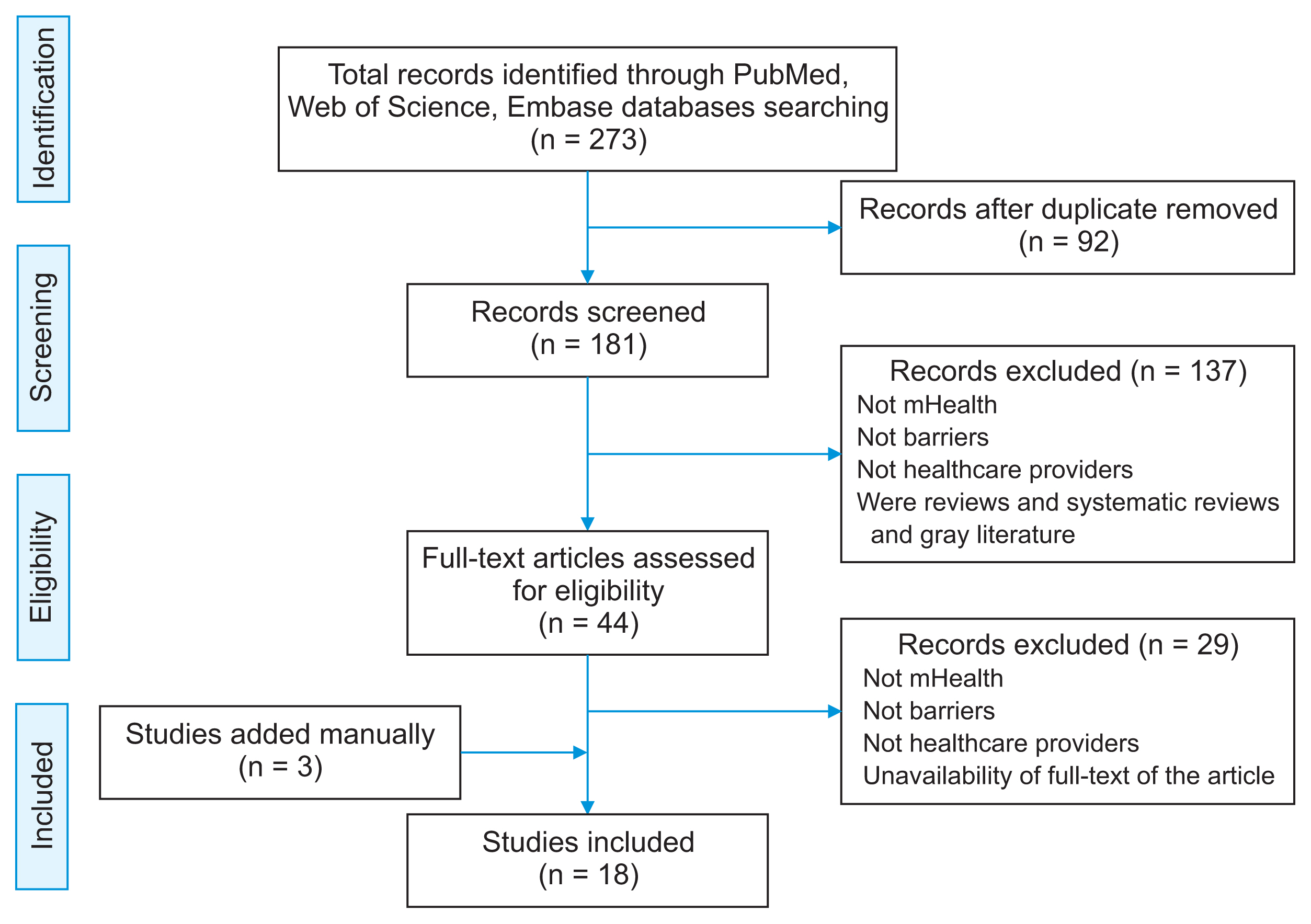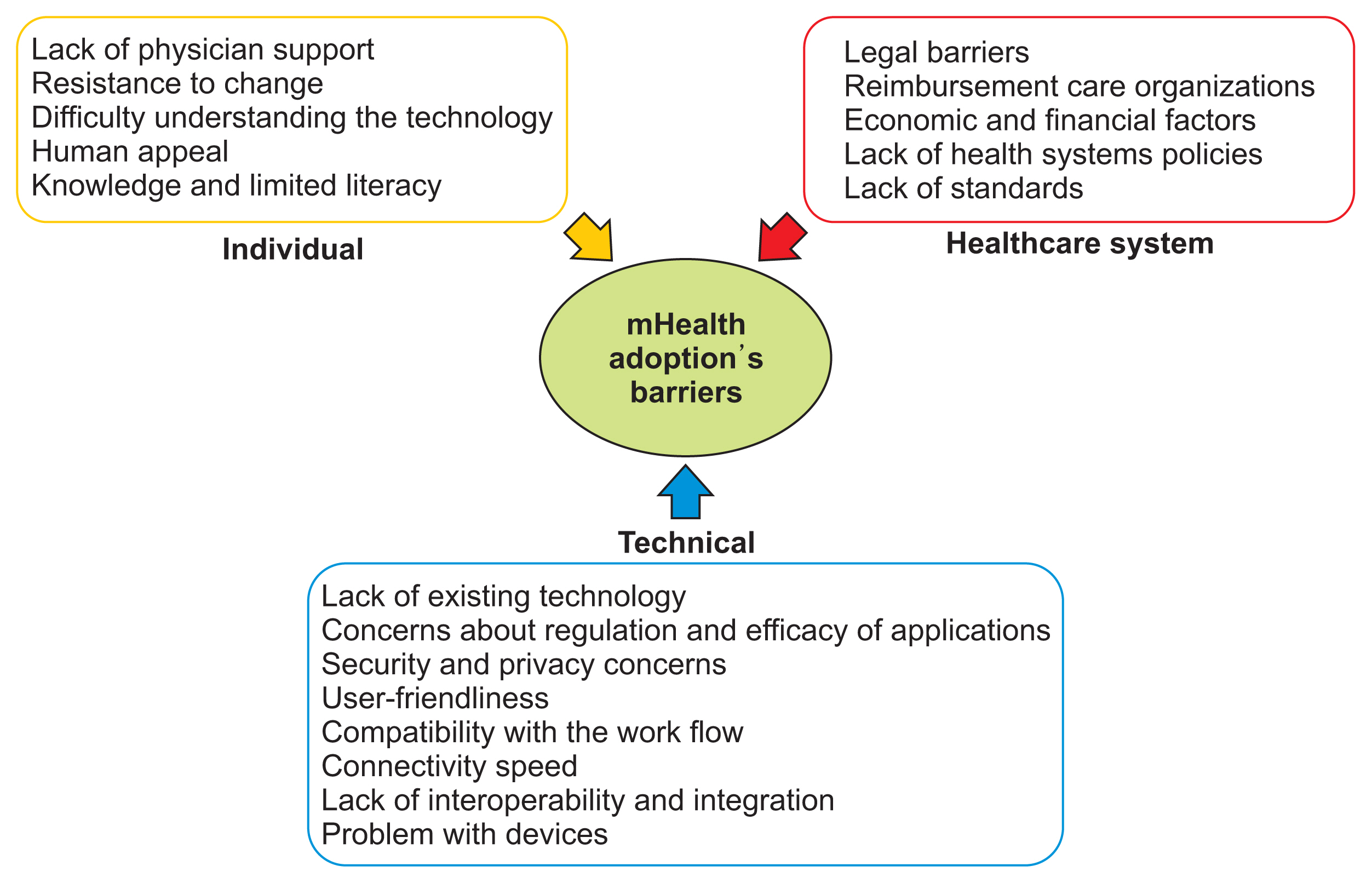Healthc Inform Res.
2021 Oct;27(4):267-278. 10.4258/hir.2021.27.4.267.
Mobile Health Technology and Healthcare Providers: Systemic Barriers to Adoption
- Affiliations
-
- 1Clinical Education Research Center, Health Human Resources Research Center, School of Health Management and Information Sciences, Shiraz University of Medical Sciences, Shiraz, Iran
- 2Department of Health Information Management, School of Allied Medical Sciences, Tehran University of Medical Sciences, Tehran, Iran
- 3Department of Health Information Technology, Faculty of Paramedicine, Hormozgan University of Medical Sciences, Bandar Abbas, Iran
- 4Amol Faculty of Paramedical Sciences, Mazandaran University of Medical Sciences, Sari, Iran
- KMID: 2522208
- DOI: http://doi.org/10.4258/hir.2021.27.4.267
Abstract
Objectives
Despite the growing use of mobile health (mHealth), certain barriers seem to be hindering the use of mHealth applications in healthcare. This article presents a systematic review of the literature on barriers associated with mHealth reported by healthcare professionals.
Methods
This systematic review was carried out to identify studies published from January 2015 to December 2019 by searching four electronic databases (PubMed/MEDLINE, Web of Science, Embase, and Google Scholar). Studies were included if they reported perceived barriers to the adoption of mHealth from healthcare providers’ perspectives. Content analysis and categorization of barriers were performed based on a focus group discussion that explored researchers’ knowledge and experiences.
Results
Among the 273 papers retrieved through the search strategy, 18 works were selected and 18 barriers were identified. The relevant barriers were categorized into three main groups: technical, individual, and healthcare system. Security and privacy concerns from the category of technical barriers, knowledge and limited literacy from the category of individual barriers, and economic and financial factors from the category of healthcare system barriers were chosen as three of the most important challenges related to the adoption of mHealth described in the included publications.
Conclusions
mHealth adoption is a complex and multi-dimensional process that is widely implemented to increase access to healthcare services. However, it is influenced by various factors and barriers. Understanding the barriers to adoption of mHealth applications among providers, and engaging them in the adoption process will be important for the successful deployment of these applications.
Figure
Reference
-
References
1. Byambasuren O, Beller E, Glasziou P. Current knowledge and adoption of mobile health apps among Australian general practitioners: survey study. JMIR Mhealth Uhealth. 2019; 7(6):e13199.
Article2. Gagnon MP, Ngangue P, Payne-Gagnon J, Desmartis M. m-Health adoption by healthcare professionals: a systematic review. J Am Med Inform Assoc. 2016; 23(1):212–20.
Article3. Garavand A, Samadbeik M, Kafashi M, Abhari S. Acceptance of health information technologies, acceptance of mobile health: a review article. J Biomed Phys Eng. 2017; 7(4):403–8.4. Ventola CL. Mobile devices and apps for health care professionals: uses and benefits. P T. 2014; 39(5):356–64.5. Hamilton EC, Saiyed F, Miller CC 3rd, Eguia A, Fonseca AC, Baum GP, et al. The digital divide in adoption and use of mobile health technology among caregivers of pediatric surgery patients. J Pediatr Surg. 2018; 53(8):1478–93.
Article6. Baniasadi T, Niakan Kalhori SR, Ayyoubzadeh SM, Zakerabasali S, Pourmohamadkhan M. Study of challenges to utilise mobile-based health care monitoring systems: a descriptive literature review. J Telemed Telecare. 2018; 24(10):661–8.
Article7. Zahmatkeshan M, Zakerabasali S, Farjam M, Gholampour Y, Seraji M, Yazdani A. The use of mobile health interventions for gestational diabetes mellitus: a descriptive literature review. J Med Life. 2021; 14(2):131–41.
Article8. Winters N, Langer L, Geniets A. Scoping review assessing the evidence used to support the adoption of mobile health (mHealth) technologies for the education and training of community health workers (CHWs) in low-income and middle-income countries. BMJ Open. 2018; 8(7):e019827.
Article9. Kaphle S, Chaturvedi S, Chaudhuri I, Krishnan R, Lesh N. Adoption and usage of mHealth technology on quality and experience of care provided by frontline workers: observations from rural India. JMIR Mhealth Uhealth. 2015; 3(2):e61.
Article10. Gagnon MP, Desmartis M, Labrecque M, Car J, Pagliari C, Pluye P, et al. Systematic review of factors influencing the adoption of information and communication technologies by healthcare professionals. J Med Syst. 2012; 36(1):241–77.
Article11. Lluch M. Healthcare professionals’ organisational barriers to health information technologies: a literature review. Int J Med Inform. 2011; 80(12):849–62.12. Nilsen ER, Dugstad J, Eide H, Gullslett MK, Eide T. Exploring resistance to implementation of welfare technology in municipal healthcare services: a longitudinal case study. BMC Health Serv Res. 2016; 16(1):657.
Article13. O’Connor S, Hanlon P, O’Donnell CA, Garcia S, Glanville J, Mair FS. Barriers and facilitators to patient and public engagement and recruitment to digital health interventions: protocol of a systematic review of qualitative studies. BMJ Open. 2016; 6(9):e010895.
Article14. Scott Kruse C, Karem P, Shifflett K, Vegi L, Ravi K, Brooks M. Evaluating barriers to adopting telemedicine worldwide: a systematic review. J Telemed Telecare. 2018; 24(1):4–12.
Article15. Adibi S. Link technologies and BlackBerry mobile health (mHealth) solutions: a review. IEEE Trans Inf Technol Biomed. 2012; 16(4):586–97.
Article16. Godoe P, Johansen T. Understanding adoption of new technologies: technology readiness and technology acceptance as an integrated concept. J Eur Psychol Stud. 2012; 3(1):38–52.
Article17. Laxman K, Krishnan SB, Dhillon JS. Barriers to adoption of consumer health informatics applications for health self management. Health Sci J. 2015; 9(5):7.18. Gleason AW. mHealth: opportunities for transforming global health care and barriers to adoption. J Electron Resour Med Libr. 2015; 12(2):114–25.19. O’Connor Y, O’Donoghue J. Contextual barriers to mobile health technology in African Countries: a perspective piece. J Mob Technol Med. 2015; 4(1):31–4.20. Medhanyie AA, Little A, Yebyo H, Spigt M, Tadesse K, Blanco R, et al. Health workers’ experiences, barriers, preferences and motivating factors in using mHealth forms in Ethiopia. Hum Resour Health. 2015; 13(1):2.
Article21. Lavariega JC, Garza R, Gomez LG, Lara-Diaz VJ, Silva-Cavazos MJ. EEMI: an electronic health record for Pediatricians: Adoption barriers, services and use in Mexico. Int J Healthc Inf Syst Inform. 2016; 11(3):57–69.22. Rajan JV, Moura J, Gourley G, Kiso K, Sizilio A, Cortez AM, et al. Understanding the barriers to successful adoption and use of a mobile health information system in a community health center in São Paulo, Brazil: a cohort study. BMC Med Inform Decis Mak. 2016; 16(1):146.
Article23. Nebeker C, Murray K, Holub C, Haughton J, Arredondo EM. Acceptance of mobile health in communities underrepresented in biomedical research: barriers and ethical considerations for scientists. JMIR Mhealth Uhealth. 2017; 5(6):e87.
Article24. Kao CK, Liebovitz DM. Consumer mobile health apps: current state, barriers, and future directions. PM R. 2017; 9(5S):S106–S115.
Article25. van Heerden A, Harris DM, van Rooyen H, Barnabas RV, Ramanathan N, Ngcobo N, et al. Perceived mHealth barriers and benefits for home-based HIV testing and counseling and other care: qualitative findings from health officials, community health workers, and persons living with HIV in South Africa. Soc Sci Med. 2017; 183:97–105.
Article26. Abelson JS, Kaufman E, Symer M, Peters A, Charlson M, Yeo H. Barriers and benefits to using mobile health technology after operation: a qualitative study. Surgery. 2017; 162(3):605–11.
Article27. Faber S, van Geenhuizen M, de Reuver M. eHealth adoption factors in medical hospitals: a focus on the Netherlands. Int J Med Inform. 2017; 100:77–89.
Article28. Graves M, Doucet S, Dube A, Johnson M. Health professionals’ and patients’ perceived barriers and facilitators to collaborating when communicating through the use of information and communication technologies. J Interprof Educ Pract. 2018; 10:85–91.
Article29. Rassi C, Gore-Langton GR, Gidudu Walimbwa B, Strachan CE, King R, Basharat S, et al. Improving health worker performance through text messaging: a mixed-methods evaluation of a pilot intervention designed to increase coverage of intermittent preventive treatment of malaria in pregnancy in West Nile, Uganda. PLoS One. 2018; 13(9):e0203554.
Article30. Spann A, Stewart E. Barriers and facilitators of older people’s mHealth usage: a qualitative review of older people’s views. Hum Technol. 2018; 14(3):264–96.
Article31. Bally EL, Cesuroglu T. Toward integration of mHealth in primary care in the Netherlands: a qualitative analysis of stakeholder perspectives. Front Public Health. 2020; 7:407.
Article32. Zhou L, Bao J, Watzlaf V, Parmanto B. Barriers to and facilitators of the use of mobile health apps from a security perspective: mixed-methods study. JMIR Mhealth Uhealth. 2019; 7(4):e11223.
Article33. Anastasiadou D, Folkvord F, Serrano-Troncoso E, Lupianez-Villanueva F. Mobile health adoption in mental health: user experience of a mobile health app for patients with an eating disorder. JMIR Mhealth Uhealth. 2019; 7(6):e12920.
Article34. Wahab SA, Rose RC, Osman SI. Defining the concepts of technology and technology transfer: a literature analysis. Int Bus Res. 2012; 5(1):61–71.
Article35. Steinhubl SR, Muse ED, Topol EJ. The emerging field of mobile health. Sci Transl Med. 2015; 7(283):283rv3.
Article36. Martinez-Perez B, de la Torre-Diez I, Lopez-Coronado M. Privacy and security in mobile health apps: a review and recommendations. J Med Syst. 2015; 39(1):181.
Article37. Bajwa M. mHealth security. Pak J Med Sci. 2014; 30(4):904–7.
Article38. Zahra F, Hussain A, Mohd H. Usability factors of mobile health application for chronic diseases. AIP Conf Proc. 2016; 1761(1):020108.
Article39. Dunlop M, Brewster S. The challenge of mobile devices for human computer interaction. Pers Ubiquitous Comput. 2002; 6:235–6.
Article40. LeRouge C, Garfield MJ. Crossing the telemedicine chasm: have the U.S. barriers to widespread adoption of telemedicine been significantly reduced? Int J Environ Res Public Health. 2013; 10(12):6472–84.
Article41. Weinstein RS, Lopez AM, Joseph BA, Erps KA, Holcomb M, Barker GP, et al. Telemedicine, telehealth, and mobile health applications that work: opportunities and barriers. Am J Med. 2014; 127(3):183–7.
Article42. Mehdipour Y, Ebrahimi S, Khammarnia M, Alipour J, Karimi A. The acceptance of mobile health services by physicians: the case of Iran. Shiraz E-Med J. 2018; 19(Suppl):e66316.
Article43. Sands DZ. Help for physicians contemplating use of e-mail with patients. J Am Med Inform Assoc. 2004; 11(4):268–9.
Article44. McDaniel AM, Schutte DL, Keller LO. Consumer health informatics: from genomics to population health. Nurs Outlook. 2008; 56(5):216–223e3.
Article45. Linsky A, Zimmerman KM. Provider and system-level barriers to deprescribing: interconnected problems and solutions. Public Policy Aging Rep. 2018; 28(4):129–33.
Article46. Zakerabasali S, Safdari R, Kadivar M, Rostam Niakan Kalhori S, Mokhtaran M, Karbasi Z, et al. Neonatal abstinence syndrome: a systematic review of current databases and registries. J Matern Fetal Neonatal Med. 2021; 34(6):979–92.
Article47. Waegemann CP. mHealth: the next generation of telemedicine? Telemed J E Health. 2010; 16(1):23–5.48. Adebesin F, Kotze P, Van Greunen D, Foster R. Barriers & challenges to the adoption of E-Health standards in Africa. In : Proceedings of Conference on Health Informatics South Africa (HISA); 2013 Jul 3–5; Port Elizabeth, South Africa.49. Menachemi N, Matthews M, Ford EW, Hikmet N, Brooks RG. The relationship between local hospital IT capabilities and physician EMR adoption. J Med Syst. 2009; 33(5):329–35.
Article
- Full Text Links
- Actions
-
Cited
- CITED
-
- Close
- Share
- Similar articles
-
- Early Experiences with Mobile Electronic Health Records Application in a Tertiary Hospital in Korea
- Factors Influencing the Adoption of Advanced Cryptographic Techniques for Data Protection of Patient Medical Records
- Ubiquitous Health in Korea: Progress, Barriers, and Prospects
- Development of Mobile Electronic Health Records Application in a Secondary General Hospital in Korea
- Association between Health Information Technology and Case Mix Index



